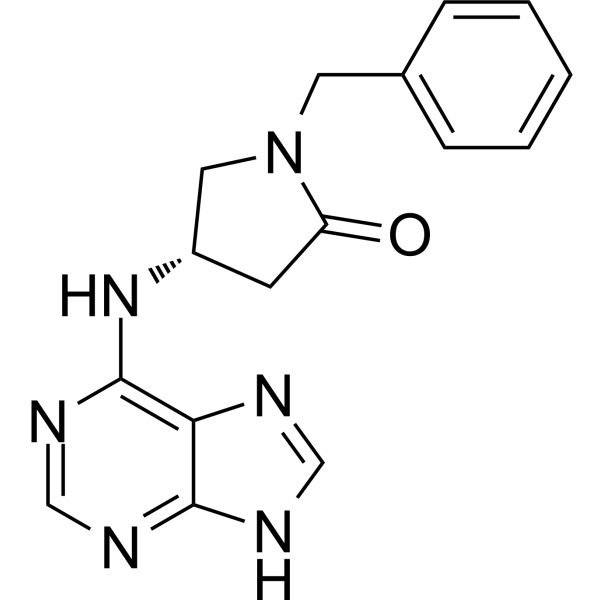Physicochemical Properties
| Molecular Formula | C16H16N6O |
| Molecular Weight | 308.3378 |
| Exact Mass | 308.138 |
| CAS # | 2550398-89-3 |
| Related CAS # | (Rac)-Benpyrine;1333714-43-4;(R)-Benpyrine |
| PubChem CID | 95327594 |
| Appearance | White to yellow solid powder |
| LogP | 1.2 |
| Hydrogen Bond Donor Count | 2 |
| Hydrogen Bond Acceptor Count | 5 |
| Rotatable Bond Count | 4 |
| Heavy Atom Count | 23 |
| Complexity | 427 |
| Defined Atom Stereocenter Count | 1 |
| SMILES | O=C1C([H])([H])[C@@]([H])(C([H])([H])N1C([H])([H])C1C([H])=C([H])C([H])=C([H])C=1[H])N([H])C1C2=C(N=C([H])N2[H])N=C([H])N=1 |
| InChi Key | HUWOMAVUXTXEKT-LBPRGKRZSA-N |
| InChi Code | InChI=1S/C16H16N6O/c23-13-6-12(8-22(13)7-11-4-2-1-3-5-11)21-16-14-15(18-9-17-14)19-10-20-16/h1-5,9-10,12H,6-8H2,(H2,17,18,19,20,21)/t12-/m0/s1 |
| Chemical Name | (4S)-1-benzyl-4-(7H-purin-6-ylamino)pyrrolidin-2-one |
| HS Tariff Code | 2934.99.9001 |
| Storage |
Powder-20°C 3 years 4°C 2 years In solvent -80°C 6 months -20°C 1 month |
| Shipping Condition | Room temperature (This product is stable at ambient temperature for a few days during ordinary shipping and time spent in Customs) |
Biological Activity
| Targets | KD: 82.1 μM (TNF-α)[1] |
| ln Vitro | Benpyrine (5–20 μM; 14 hours; RAW264.7 cells) pretreatment causes a dose-dependent reduction in RAW264's IκBα phosphorylation.Ten milligrams of TNF-α or one microgram of LPS per milliliter were used to stimulate seven cells. In RAW264, benpyrine reverses the nuclear translocation of NF-κB/p65 caused by TNF-α.7 cells [1]. Benpyrine raised cell survival to 80% and only prevented TNF-α-induced cell death in WT and Y119A. Benpyrine has no discernible effect on the cytotoxicity of L929 induced by Y59L and L57A [1]. |
| ln Vivo | Benpyrine treatment (25–50 mg/kg; oral gavage; daily; for 2 weeks; Balb/c mice) markedly reduced the symptoms of arthritis produced by collagen. IFN-γ, IL-1β, and IL-6 are examples of pro-inflammatory cytokines whose levels are dose-dependently decreased by benpyrine, while the concentration of the anti-inflammatory cytokine IL-10 is increased [1]. Benpyrine (25 mg/kg) was found to lessen TNF-α-induced inflammation in a mouse model of endotoxemia, which in turn lessened liver and lung injury [1]. |
| Cell Assay |
Western Blot Analysis[1] Cell Types: RAW264.7 cells Tested Concentrations: 5 µM, 10 µM, 20 µM Incubation Duration: 14 hrs (hours) Experimental Results: Resulted in a dose-dependent decrease in the phosphorylation of IκBα. |
| Animal Protocol |
Animal/Disease Models: balb/c (Bagg ALBino) mouse: (18-20 g) injected with collagen[1] Doses: 25 mg/kg, 50 mg/kg Route of Administration: po (oral gavage); daily; for 2 weeks Experimental Results: Relieved the symptoms of collagen-induced arthritis in mice. |
| References |
[1]. Discovery of an Orally Active Small Molecule TNF-α Inhibitor. J Med Chem. 2020 Jul 15. |
Solubility Data
| Solubility (In Vitro) | DMSO : 12.5 mg/mL (40.54 mM) |
| Solubility (In Vivo) |
Solubility in Formulation 1: ≥ 1.25 mg/mL (4.05 mM) (saturation unknown) in 10% DMSO + 40% PEG300 + 5% Tween80 + 45% Saline (add these co-solvents sequentially from left to right, and one by one), clear solution. For example, if 1 mL of working solution is to be prepared, you can add 100 μL of 12.5 mg/mL clear DMSO stock solution to 400 μL PEG300 and mix evenly; then add 50 μL Tween-80 to the above solution and mix evenly; then add 450 μL normal saline to adjust the volume to 1 mL. Preparation of saline: Dissolve 0.9 g of sodium chloride in 100 mL ddH₂ O to obtain a clear solution. Solubility in Formulation 2: ≥ 1.25 mg/mL (4.05 mM) (saturation unknown) in 10% DMSO + 90% (20% SBE-β-CD in Saline) (add these co-solvents sequentially from left to right, and one by one), clear solution. For example, if 1 mL of working solution is to be prepared, you can add 100 μL of 12.5 mg/mL clear DMSO stock solution to 900 μL of 20% SBE-β-CD physiological saline solution and mix evenly. Preparation of 20% SBE-β-CD in Saline (4°C,1 week): Dissolve 2 g SBE-β-CD in 10 mL saline to obtain a clear solution. Solubility in Formulation 3: ≥ 1.25 mg/mL (4.05 mM) (saturation unknown) in 10% DMSO + 90% Corn Oil (add these co-solvents sequentially from left to right, and one by one), clear solution. For example, if 1 mL of working solution is to be prepared, you can add 100 μL of 12.5 mg/mL clear DMSO stock solution to 900 μL of corn oil and mix evenly. (Please use freshly prepared in vivo formulations for optimal results.) |
| Preparing Stock Solutions | 1 mg | 5 mg | 10 mg | |
| 1 mM | 3.2432 mL | 16.2159 mL | 32.4317 mL | |
| 5 mM | 0.6486 mL | 3.2432 mL | 6.4863 mL | |
| 10 mM | 0.3243 mL | 1.6216 mL | 3.2432 mL |
